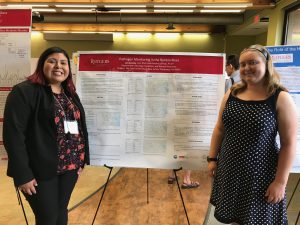The Rutgers Raritan River Consortium (R3C) is dedicated to providing students, especially those from diverse backgrounds, with opportunities to access and study the Raritan alongside professionals, stakeholders and decision-makers. Similarly, the RISE at Rutgers program, run by the Rutgers School of Graduate Studies, works to engage undergraduate students from across the United States in research experiences under the guidance of Rutgers’ faculty mentors. Thus, a natural collaboration was formed and in the summer of 2019, the R3C was able to provide this opportunity to two RISE interns: Jael Estrada and Elmer Gonzalez.

Jael Estrada, environmental science major from Drew University, at RISE poster session with Rutgers mentor Julie Blum.,
Pathogen Monitoring in the Raritan River – Jael Estrada, an environmental science major from Drew University, collaborated with Rutgers mentors Richard Lathrop, Julie Blum, Michele Bakacs and Lower Raritan Watershed Partnership’s Heather Fenyk to track pathogen levels along the lower Raritan River. In monitoring access points to the River, this project aimed to better inform stakeholders on the status of the River as well as work to understand interactions between pathogen levels and weather, land use, and water quality indicators. Additional information on the project can be found here.
Comparison of heavy metal concentrations in two New Jersey rivers – The industrial history of the Raritan River has led to a legacy of heavy metal contamination. In this study, Elmer Gonzalez, an undergraduate chemistry major from the University of Puerto Rico-Mayaguez, worked with Rutgers mentors Silke Severmann and Sylvie Bruggmann to look at metal contamination in both the Raritan River water itself as well as the particles suspended in the water. They also compared this data to the levels of arsenic, lead, cadmium, tungsten, copper, and chromium in the Mullica River, a more pristine and theoretically less contaminated water body. What Elmer found was that both rivers demonstrated low metal contamination and that the difference between them was not as clear as anticipated.
For more information contact Carrie Ferraro, Associate Director, Coastal Climate Risk & Resilience Initiative and co-Facilitator, Rutgers Raritan River Consortium at ferraro@marine.rutgers.edu or (848) 932-3282.